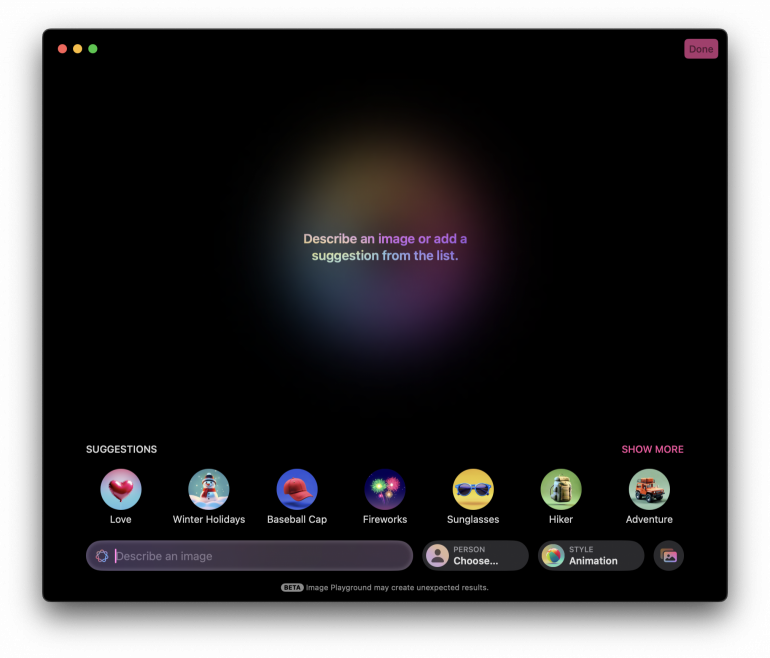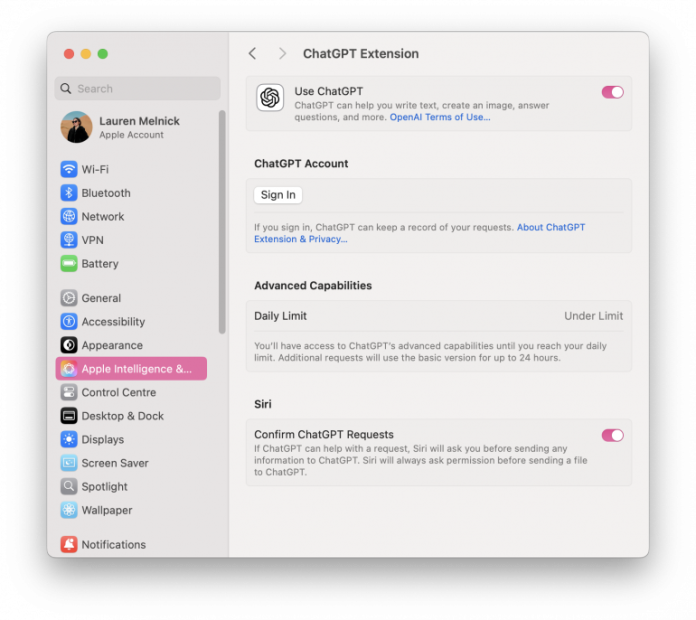Apple Intelligence on Mac: Everything You Need to Know About Apple’s AI Features

Image by: Dall-E
Artificial intelligence (AI) is changing how we interact with technology, each other, and how we work. With so much disruption across the board, it’s unsurprising that one of tech’s prominent innovators, Apple, has developed Apple Intelligence for Mac – the brand’s distinct approach to AI-powered features.
However, it’s not another AI system.
Apple Intelligence’s main goal is to improve user experience across macOS, iOS, and iPadOS in a way that feels natural, intuitive, and, most importantly, private.
First introduced in 2024, Apple Intelligence is built directly into macOS and iOS and focuses on delivering AI that is genuinely useful in everyday life. After initial delays in Europe due to regulatory compliance, Apple Intelligence became available to EU users in April 2025, along with support for multiple languages beyond English.
While the rollout hasn’t been without controversy—notably, Apple faced criticism for overpromising on advanced Siri features that were quietly delayed until 2026—the core Apple Intelligence capabilities are enhancing the Mac experience today.
From smarter writing assistance to better photo editing and more intuitive Siri interactions, Apple Intelligence is making your Mac feel more intuitive than ever.
In this guide, we’ll explore everything you need to know about Apple Intelligence on Mac, from the latest features to how it compares with AI tools like ChatGPT and what’s coming next.
Table of Contents
TOC
How Does Apple Intelligence Work?
Apple Intelligence works in the background, understanding and responding to you in real-time. Whether drafting an email, editing a photo, or managing your schedule, it intelligently assists by leveraging on-device data while prioritizing your privacy.
To strike the perfect balance between performance and security, Apple uses a hybrid approach:
- On-Device Processing: Handles quick tasks instantly, keeping data private.
- Private Cloud Compute (PCC): Steps in for more complex AI functions while ensuring no personal data is stored or accessible.
Unlike traditional AI models that rely on remote servers, Apple Intelligence keeps your information secure and anonymized, even when extra computing power is needed.
Rather than aiming for the most powerful AI, Apple focuses on practical, seamless intelligence to help you write better, stay organized, and communicate effortlessly.
It’s AI that feels intuitive, useful, and unmistakably Apple.
Apple Intelligence Features on Mac
Apple Intelligence introduces a suite of AI-powered tools to improve your productivity, work habits, creativity, and communication across iOS and macOS devices. Most of these features are now available globally, including in Europe as of April 2025, with support for multiple languages.
Here’s everything you need to know about the Apple Intelligence features currently available on your Mac.
Writing Tools

Apple Intelligence brings powerful AI-assisted Writing Tools to your Mac, helping you easily craft clear, compelling text.
Seamlessly integrated into Mail, Notes, Pages, and other third-party apps, these tools go beyond basic grammar and punctuation errors. Use the tool to improve your writing, summarize key information and refine your tone to match intent.
Key Features:
- Grammar Correction: Automatically identify and fix typos, punctuation errors, and grammar mistakes.
- Style Suggestions: Get instant recommendations to improve your tone, clarity, and readability in emails, documents, and messages.
- Rewriting Assistance: Highlight text and request alternative phrasings, a different tone, or a concise summary.
Availability:
- macOS 15.1 or later on Mac models with M1 or later.
- iOS 18.1 or later on all iPhone 16 models, iPhone 15 Pro, and iPhone 15 Pro Max.
- Available globally, including Europe, with support for multiple languages.


Managing your inbox just got smarter.
Transform how you handle emails using AI-driven sorting, smart replies, and intelligent summaries to cut through clutter and highlight what matters most.
It can prioritize urgent messages, condense long email threads into key points, and even suggest context-aware responses, helping you communicate more efficiently without getting lost in endless threads.
Key Features:
- Priority Messages: Automatically identifies urgent emails and messages. It highlights emails from important contacts, time-sensitive notifications, and event invitations.
- Smart Reply: Uses AI to generate quick, context-aware responses. Smart Reply tailors responses to the tone of your conversation, whether you need a formal reply to a work email or a casual response to a friend,
- AI Summaries: Condense long email threads and message conversations into short, easy-to-read highlights.
Availability:
- macOS 15.1 or later on Mac models with M1 or later.
- iOS 18.1 or later on all iPhone 16 models, iPhone 15 Pro, and iPhone 15 Pro Max.
- Available globally, including Europe, with support for multiple languages.
Image Playground

Image by: Apple
Apple’s Image Playground brings generative AI creativity to macOS, allowing you to generate original images with a description instantly.
Use it to illustrate an idea, enhance a message, or experiment with different artistic styles. Fully integrated into Messages, Notes, and other Apple apps, it offers a more accessible and secure alternative to external tools like DALL·E and MidJourney.
Key Features:
- AI-Generated Artwork: Users can type a description like “a futuristic city skyline at sunset,” and Image Playground will generate custom artwork.
- Deep Integration: Integrates with apps like Messages and Notes, allowing you to generate and share images without switching apps.
- Personalized Styles: The tool adapts generated images to user preferences, creating consistency with existing visuals.
Availability:
- macOS 15.2 or later on Mac models with M1 or later.
- iOS 18.2 or later on all iPhone 16 models, iPhone 15 Pro, and iPhone 15 Pro Max.
- Available globally, including Europe, with support for multiple languages.
AI-Generated Emojis (Genmoji)

Photo by: Apple
Genmoji reimagines emoji creation with the power of Apple Intelligence, allowing you to generate custom, AI-crafted emojis that match your unique expressions and personality.
Describe what you need, and Genmoji will bring it to life. Seamlessly integrated into Messages and other Apple apps, the feature creates conversations that are more expressive, creative, and distinctly yours.
Key Features:
- Custom Emoji Creation: Describe what you want, and Apple Intelligence will generate a matching emoji.
- Personalized Style: AI adapts Genmoji to match your frequently used emojis, giving you a consistent tone and appearance.
- Seamless Integration: Gemoji works across native apps like Messages, Notes, and other third-party apps.
Availability:
- macOS 15.2 or later on Mac models with M1 or later.
- iOS 18.2 or later on all iPhone 16 models, iPhone 15 Pro, and iPhone 15 Pro Max.
- Available globally, including Europe, with support for multiple languages.
Photos

Your gallery just got smarter with a more intuitive way to organize, edit, and relive your memories.
The AI-powered search feature helps you find any photo instantly using natural language. The auto-generated Memory Movies crafts dynamic stories from your best moments with curated music and transitions.
Key Features:
- Create Memory Movies: Describe a theme or story, and Apple Intelligence will automatically select relevant photos, videos, and music to create a beautifully edited Memory movie.
- AI-Powered Search: Use natural language queries to find specific photos or moments. Search for descriptions like “sunset at the beach last summer” or “Charlie’s graduation ceremony.”
- Clean Up Tool: Easily remove unwanted objects or distractions in images. Whether it’s a photobomber or clutter in the background, Apple Intelligence removes elements with a simple tap, brush, or selection.
- Smart Video Search: Search within videos to find specific moments using descriptions or keywords—perfect for quickly locating highlights in long recordings.
Availability:
- macOS 15.1 or later on Mac models with M1 or later.
- iOS 18.1 or later on all iPhone 16 models, iPhone 15 Pro, and iPhone 15 Pro Max.
- Available globally, including Europe, with support for multiple languages.
Visual Intelligence with Camera Control
Visual Intelligence expands how you interact with the world using AI-powered object recognition on your iPhone.
Analyzing what’s in view can provide instant insights, identify objects, and connect you to sources like Google Search or ChatGPT for further exploration.
With real-time recognition and a privacy-focused approach, discovery is faster, smarter, and seamlessly integrated into your device.
Key Features:
- Instant Object Recognition: Press and hold the Camera Control button to capture an object, and Apple Intelligence will identify it in seconds.
- AI-Powered Lookup: Choose to search using Google or send the image directly to ChatGPT for additional insights.
- Privacy-Focused Processing: The captured image is not stored on your device, and Apple doesn’t retain a copy.
- Enhanced Learning: Quickly discover new information about landmarks, products, plants, or animals.
Availability:
- Only available in iOS 18.2 or later on all iPhone 16 models.
- Available globally, including Europe.
Smart Notifications and AI Summaries

Image by: Apple
Smart Notifications and AI Summaries streamline alert management, ensuring only the most relevant messages, emails, and updates capture your attention.
Instead of overwhelming you with endless notifications, Apple Intelligence prioritizes what matters, condensing long threads into clear, actionable insights and helping you reduce screen time. With AI-driven filtering and intelligent summaries, staying informed becomes effortless.
There are no distractions, just the information you need when you need it.
Key Features:
- AI Summarization: Apple Intelligence automatically condenses long notifications, emails, and messages into clear, digestible summaries, highlighting the most relevant details.
- Smart Prioritisation: AI intelligently sorts notifications based on importance, ensuring that urgent updates and essential messages take priority.
- Customizable Summaries: Users can fine-tune how and when notifications are summarised, allowing for a personalized and distraction-free experience.
- Universal App Support: Initially available for Mail and Messages, notification summarization now works across all apps in iOS 18.1 and macOS 15.4.
Availability:
- macOS 15.1 or later on Mac models with M1 or later.
- iOS 18.1 or later on all iPhone 16 models, iPhone 15 Pro, and iPhone 15 Pro Max.
- Available globally, including Europe, with support for multiple languages.
Reduce Interruptions Focus vs Standard Focus Mode

Photo by: Apple
Reduce Interruptions takes Focus Mode to the next level by using Apple Intelligence to prioritize essential notifications while filtering out distractions.
Unlike the traditional focus settings on Apple that mute alerts, the AI-driven feature dynamically assesses urgency to make sure you don’t accidentally miss something important.
Key Features:
- Intelligent Notification Filtering: Unlike standard Focus Modes, Reduce Interruptions doesn’t just silence all alerts. It uses AI to determine which notifications matter and lets the important ones through.
- Intelligent Breakthrough & Silencing: This new setting allows Apple Intelligence to override standard Focus Mode rules when it detects a high-priority notification (e.g., an urgent message or time-sensitive reminder).
- Dynamic Adjustments: Over time, Apple Intelligence learns from your behavior to refine what gets through and what stays silent.
Seamless Focus Mode Integration: The feature works with existing Focus Modes, allowing for a more context-aware experience.
Key Differences Between Reduce Interruptions vs. Standard Focus Mode
| Feature | Reduce Interruptions | Standard Focus Mode |
| AI-Driven Notification Filtering | ✅ | ❌ |
| Learns from User Behaviour | ✅ | ❌ |
| Allows Critical Notifications | ✅ | ✅ (if manually configured) |
| Automatically Adjusts Over Time | ✅ | ❌ |
Availability:
- macOS 15.1 or later on Mac models with M1 or later.
- iOS 18.1 or later on all iPhone 16 models, iPhone 15 Pro, and iPhone 15 Pro Max.
- Available globally, including Europe, with support for multiple languages.
Advanced Siri Integration

Apple Intelligence has brought some improvements to Siri, making it a more conversational and context-aware assistant across all your Apple devices. With enhanced language processing, Siri is better at understanding your requests and maintaining context across conversations.
However, it’s important to note that the most ambitious Siri features Apple showcased at WWDC 2024—including personal context awareness and on-screen content recognition—have been delayed. Apple executives confirmed that these advanced capabilities won’t arrive until 2026, acknowledging that “it’s going to take us longer than we thought to deliver on these features.”
Currently Available Features:
- More Natural Conversations: Siri now remembers context across multiple interactions, allowing for more natural follow-up questions without full clarification.
- Type to Siri: Users can now type to Siri and seamlessly switch between text and voice input.
- Better Speech Recognition: Siri handles stumbles in speech more gracefully, making interactions feel smoother.
- Basic System Integration: Siri can control more settings and assist with simple multi-step actions across macOS, iOS, and iPadOS.
Delayed Until 2026:
- Personal Context Awareness: The ability for Siri to access and understand your emails, messages, and personal data to answer questions like “What was that restaurant Mark recommended?” remains in development.
- On-Screen Awareness: Features that would let Siri understand what’s on your screen and take actions based on that content have been postponed.
- Advanced In-App Actions: The promised expansion of app intents that would allow Siri to perform complex actions within and across apps won’t arrive as originally planned.
Availability:
- macOS 15.2 or later on Mac models with M1 or later.
- iOS 18.2 or later on all iPhone 16 models, iPhone 15 Pro, and iPhone 15 Pro Max.
- Available globally, including Europe.
ChatGPT Integration

Apple Intelligence integrates with ChatGPT, expanding Siri and Writing Tools with advanced reasoning and deeper contextual understanding. When a query requires more complexity, Apple Intelligence intelligently leverages GPT-4o, delivering richer responses while maintaining Apple’s strict privacy standards.
Key Features:
- Siri + ChatGPT: When Siri encounters a complex request, it can determine when to send queries to ChatGPT to give you answers with richer insights.
- Writing Tools + ChatGPT: Apple’s AI-assisted Writing Tools now leverage ChatGPT for advanced text generation, creative writing, and summarization.
- System-Wide AI Access: ChatGPT is available on iOS, macOS, and iPadOS and integrates into apps like Notes, Mail, and Safari.
- Opt-In & Privacy-Focused: Users must opt in before Siri or Writing Tools send any data to OpenAI. Requests are anonymized, and IP addresses remain hidden to protect user privacy.
- Paid Subscription Perks: ChatGPT Plus subscribers can sign in to unlock expanded GPT-4o usage and premium features across Apple devices.
- Future Model Expansion: Apple plans to integrate other AI models, including Google’s Gemini, giving users more choices for advanced AI assistance.
Availability:
- macOS 15.2 or later on Mac models with M1 or later.
- iOS 18.2 or later on all iPhone 16 models, iPhone 15 Pro, and iPhone 15 Pro Max.
How to Use Apple Intelligence on Mac
Ready to explore its capabilities? Follow these simple steps to enable Apple Intelligence on your Mac.
Step 1: Check Compatibility
- Ensure your Mac is running macOS 15.3 or later.
- To check, go to Apple menu > About This Mac.
For more details on device eligibility and rollout timelines, see the Appendix: How to Get Apple Intelligence on Your Mac.
Step 2: Enable Apple Intelligence
- Open the Apple menu > System Settings.
- Click Apple Intelligence & Siri.
- Click Get Apple Intelligence to activate AI-powered features.
Step 3: Use an Apple Intelligence Feature
- Ask Siri more complex, contextual questions with typed or voiced commands.
- Open Notes, Mail, or Pages and highlight text to see options for rewriting, summarising, or improving tone.
- In Messages or Notes, type a description and select Genmoji to generate a custom emoji.
How to Disable Apple Intelligence
If you prefer not to use Apple Intelligence, Apple provides an easy way to turn it off.
Here’s how:
Step 1: Open the Apple menu > System Settings.
Step 2: Click Apple Intelligence & Siri.
Step 3: Toggle Apple Intelligence off.
Apple Intelligence vs. ChatGPT and Other AI Tools
Apple Intelligence is built around its privacy-first approach. This sets it apart from other AI models like ChatGPT, Google Gemini, and Microsoft Copilot.
While these models focus on advanced AI-driven responses and deep customization, Apple Intelligence prioritizes seamless system integration and on-device processing to protect your data and privacy.
Here are the key differences:
| Feature | Apple Intelligence | ChatGPT/ Gemini / Copilot |
| Privacy | On-device processing + Private Cloud Compute (PCC) | Cloud-based, data stored on external servers |
| Integration | Built into macOS, iOS, and iPadOS | Web-based or app-dependent |
| Customization | Limited, Apple-controlled AI models | Highly customizable API integrations |
| Functionality | System-wide AI (Siri, Writing Tools, Photos, etc.) | General-purpose chatbot & content creation |
| Third-Party AI Access | Uses ChatGPT for complex queries (opt-in) | Full AI model flexibility |
It’s important to note that Apple Intelligence isn’t competing with standalone AI models. Its focus is making Apple’s devices more intuitive and improving the user experience through blending AI into everyday tasks without sacrificing security.
ChatGPT, Gemini, or Copilot may be better options for users seeking advanced AI-driven creativity. However, Apple Intelligence is unmatched for those who want AI that “just works” across Apple devices.
Explore more AI app options in our roundup of the best AI apps for Mac, comparing chatbots, writing assistants, creative tools, and more.
Looking Ahead: What’s Next for Apple Intelligence?
Apple Intelligence continues to evolve, with major updates announced at WWDC 2025 and more features on the horizon. Here’s what’s coming next:
Features Coming in Fall 2025 (iOS 26/macOS 26)
Live Translation: Apple is introducing system-wide real-time translation that works entirely on-device. This feature will automatically translate text and speech in apps like Messages, FaceTime, and Phone calls, allowing seamless conversations across language barriers while maintaining privacy.
Expanded Visual Intelligence: Building on the current Camera-based object recognition, Apple is extending visual intelligence to work with any content on your screen. Users will be able to long-press or use a command to get AI-powered information or actions on whatever they’re viewing—from identifying items in photos to searching for products shown in any app.
Enhanced Creative Tools:
- Advanced Genmoji: Users will be able to combine multiple emoji or add descriptive text to generate more complex, personalized emojis.
- Image Playground “Any Style”: Powered by ChatGPT integration, users can request images in specific art styles (oil painting, vector art, etc.) or provide reference images to guide generation.
Productivity Enhancements:
- One-Click Email Summaries: Mail will offer instant summarization of long emails or threads into key bullet points.
- Audio Transcript Summaries: Notes will automatically summarize audio transcripts and highlight important information from meeting recordings.
- Lock Screen Intelligence: Long notification stacks will be collapsed into AI-generated summaries directly on the Lock Screen.
Developer Access: Apple unveiled the Foundation Models framework at WWDC 2025, giving third-party developers access to the same on-device AI model that powers Apple Intelligence. With just a few lines of Swift code, developers can integrate Apple’s AI into their apps while maintaining privacy through on-device processing.
Shortcuts Integration: Siri Shortcuts will be able to directly leverage Apple Intelligence, allowing users to create powerful automations that include AI-powered text summarization, translation, or image generation as part of their workflows.
Delayed Until 2026: Advanced Siri Features
The most anticipated Siri enhancements—including personal context awareness, on-screen content recognition, and complex multi-app actions—have been delayed until 2026. These features, which would allow Siri to understand queries like “What’s the best route to make my flight on time?” by accessing multiple apps and personal data, require significant architectural improvements that Apple is still developing.
Continued Global Expansion
Apple Intelligence now supports multiple languages including French, German, Spanish, Japanese, and more. Additional languages like Danish, Dutch, Swedish, and Turkish are expected by the end of 2025, making Apple Intelligence accessible to an even broader global audience.
The Road Ahead
By the end of 2025, Apple Intelligence will be deeply integrated across all Apple platforms, with privacy remaining the cornerstone of every feature. While some promised capabilities have taken longer than expected, Apple’s commitment to getting the technology right before release—rather than rushing incomplete features to market—continues to guide the evolution of Apple Intelligence.
The Future of AI on Mac Has Only Just Begun
Apple Intelligence marks a new era of AI blending into macOS to enhance productivity, creativity, and everyday tasks without overwhelming users with unnecessary complexity. With on-device processing, Private Cloud Compute (PPC), and deep system integration, it offers privacy and efficiency that other AI models can’t match.
For those seeking AI-powered productivity in addition to Apple’s ecosystem, Timing’s AI Summaries provide an alternative, offering intelligent time tracking and workflow insights.
Try Timing free for 30 days and experience AI-driven productivity today.
Frequently Asked Questions: Apple Intelligence Mac
What is Apple Intelligence on Mac?
Apple Intelligence is Apple’s built-in AI system that enhances productivity, creativity, and efficiency across macOS. It offers AI-assisted writing tools, smarter Siri interactions, Genmoji, AI-powered image generation, and notification summaries. Unlike cloud-based AI models, Apple Intelligence prioritizes on-device processing and Private Cloud Compute to maintain user privacy.
How Can I Ensure That Apple Intelligence is Enabled on My Mac?
To enable Apple Intelligence on your Mac, update to macOS 15.1 or later. However, we suggest upgrading to macOS 15.3, as it includes more of the AI features. Then, go to the Apple menu > System Settings > Apple Intelligence & Siri and click Get Apple Intelligence to activate it. Once activated, AI-powered features like smart writing tools, Genmoji, and enhanced Siri will be available across macOS.
How Do I Use Apple Intelligence on Mac?
To use Apple Intelligence on your Mac, ensure your device runs macOS 15.1 or later. Then, go to the Apple menu > System Settings > Apple Intelligence & Siri and click Get Apple Intelligence to enable AI-powered features. Once activated, you can use AI writing tools in Mail and Notes, generate Genmoji, enhance Photos, and access the improved Siri for smarter assistance.
Appendix: How to Get Apple Intelligence on Your Mac
As mentioned earlier, Apply Intelligence is gradually rolling out worldwide for Mac users. However, not every device is eligible. Your access will depend on hardware, software updates, and region-specific availability.
Here’s everything you need to know about getting Apple Intelligence on your Mac.
1. Device Compatibility: Does Your Apple Device Support Apple Intelligence?
Not all Macs and iOS devices will receive Apple Intelligence. The AI technology requires Apple’s Neural Engine, which is only available on M1 chips and later.
Here is a list of the supported Mac Models:
- MacBook Air (M1, 2020) and newer
- MacBook Pro (M1, 2020) and newer
- Mac mini (M1, 2020) and newer
- iMac (M1, 2021) and newer
- Mac Studio (M1 Max, M1 Ultra, 2022) and newer
- Mac Pro (M2 Ultra, 2023) and newer
- iPhone 16 models, iPhone 15 Pro, or iPhone 15 Pro Max
- Any iPad with A17 Pro or M1 and later
You’ll also need 7GB of storage, and your device language needs to be set to English until other languages are rolled out later in 2025.
2. macOS Requirements: Update to macOS 15.1 or Later
Apple Intelligence is only available on macOS 15.1 or later. If you’re still using an older macOS version, you’ll need to update to the latest macOS Sequoia build.
How to Update Your Mac:
- Open System Settings → Click General → Select Software Update.
- If macOS 15.1 or later is available, click Download and Install.
- Restart your Mac after installation to activate Apple Intelligence features.
3. Availability Timeline: When Will You Get Apple Intelligence?
Apple Intelligence has rolled out globally, with availability depending on device, software version, and location.
Rollout Timeline:
- July 2024: First released to developers and beta testers
- October 2024: Partial rollout in iOS 18.1, macOS 15.1, and iPadOS 18.1
- December 2024: Expanded to English-speaking regions beyond the U.S. (UK, Australia, Canada, New Zealand, South Africa)
- April 2025: Rolled out in the European Union with support for multiple languages including French, German, Spanish, Italian, Portuguese, Japanese, Korean, and Simplified Chinese
- June 2025: Apple previewed next-generation Apple Intelligence features at WWDC 2025, coming in iOS 19/macOS 16
- Fall 2025: Expected release of Live Translation, expanded Visual Intelligence, and developer API access
- 2026: Advanced Siri features with personal context awareness expected to arrive
